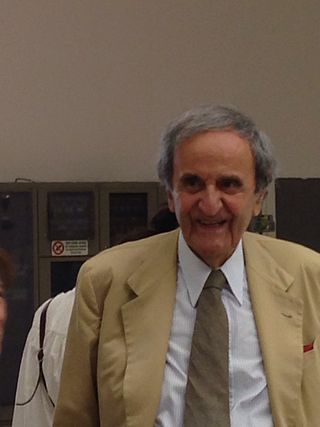
Ulm is the sixth-largest city of the southwestern German state of Baden-Württemberg, and with around 129,000 inhabitants, it is Germany's 60th-largest city.

Leibniz University Hannover, also known as the University of Hannover, is a public research university located in Hanover, Germany. Founded on 2 May 1831 as Higher Vocational School, the university has undergone six periods of renaming, its most recent in 2006.

Olivetti S.p.A. is an Italian manufacturer of computers, tablets, smartphones, printers and other such business products as calculators and fax machines. Headquartered in Ivrea, in the Metropolitan City of Turin, the company has been part of the Telecom Italia Group since 2003.

Braun GmbH is a German consumer products company founded in 1921 and based in Kronberg im Taunus. The company is known for its design aesthetic from the 1960s through the 1980s, which included products such as electric shavers, radiograms and record players, movie cameras, slide projectors, clocks, and small kitchen appliances for which "Braun became shorthand for reliable, no-nonsense modernist goods."

Max Bill was a Swiss architect, artist, painter, typeface designer, industrial designer and graphic designer.

Jasper Morrison is an English product and furniture designer. He is known for the refinement and apparent simplicity of his designs. In a rare interview with the designer, he is quoted as saying: "Objects should never shout."

Dieter Rams is a German industrial designer who is most closely associated with the consumer products company Braun, the furniture company Vitsœ, and the functionalist school of industrial design. His unobtrusive approach and belief in "less, but better" design has influenced the practice of design, as well as 20th century aesthetics and culture. He is quoted as stating that "Indifference towards people and the reality in which they live is actually the one and only cardinal sin in design."

The GT4 is an articulated tram vehicle built by Maschinenfabrik Esslingen from 1959 until 1965.

The TW 2000 is a Stadtbahn vehicle in operation on the Hanover Stadtbahn network in Hanover, Germany.

Germany has an extensive number of tramway networks. Some of these networks have been upgraded to light rail standards, called Stadtbahn in German. Straßenbahn and Stadtbahn schemes are usually operated on the legal foundation of the BOStrab, the Tramways Act of Germany.

The Cologne Stadtbahn is a light rail system in the German city of Cologne, including several surrounding cities of the Cologne Bonn Region. The term Stadtbahn denotes a system that encompasses elements of trams as well as an underground railway network (U-Bahn) and interurban rail, even including three lines that are licensed as heavy rail and used by freight trains as well as Stadtbahn vehicles. Two of these lines connect the Cologne Stadtbahn to the Bonn Stadtbahn. These lines are jointly operated by both cities' transport authorities, resulting in both systems and the lines connecting them sometimes collectively referred to as Stadtbahn Rhein-Sieg.

The Stuttgart Stadtbahn is a semi-metro system in Stuttgart, Germany. The Stadtbahn began service on 28 September 1985. It is operated by the Stuttgarter Straßenbahnen AG (SSB), which also operates the bus systems in that city. The Stuttgart Stadtbahn is successor system of a tram network (Straßenbahnen) that characterized the urban traffic in Stuttgart for decades.

The Ulm School of Design was a college of design based in Ulm, Germany. It was founded in 1953 by Inge Aicher-Scholl, Otl Aicher and Max Bill, the latter being first rector of the school and a former student at the Bauhaus. The HfG quickly gained international recognition by emphasizing the holistic, multidisciplinary context of design beyond the Bauhaus approach of integrating art, craft and technology. The subjects of sociology, psychology, politics, economics, philosophy and systems-thinking were integrated with aesthetics and technology. During HfG operations from 1953–1968, progressive approaches to the design process were implemented within the departments of Product Design, Visual Communication, Industrialized Building, Information and Filmmaking.

Tomás Maldonado was an Argentine painter, designer and thinker, considered one of the main theorists of design theory of the legendary Ulm Model, a design philosophy developed during his tenure (1954–1967) at the Ulm School of Design in Germany.
Horst Wilhelm Johannes Rittel was a design theorist and university professor. He is best known for popularizing the concept of wicked problem, but his influence on design theory and practice was much wider.

The Karlsruhe Stadtbahn is a German tram-train system combining tram lines in the city of Karlsruhe with railway lines in the surrounding countryside, serving the entire region of the middle upper Rhine valley and creating connections to neighbouring regions. The Stadtbahn combines an efficient urban railway in the city with an S-Bahn, overcoming the boundary between trams and trains. Its logo does not include the green and white S-Bahn symbol used in other German suburban rail systems and the symbol is only used at stops and stations outside the inner-city tram-operation area.
James Irvine was a British industrial designer who created furniture and product designs for many well known companies and brands such as Artemide, B&B Italia, Cappellini, Foscarini, Ikea, Magis, Muji, Thonet, and WMF. He once described the product designer's job as “the work of an unknown hero.”

Hans G. Conrad was a photographer and graphic designer in the 20th century.

Herbert Hirche was a German architect and furniture and product designer.

Hans Gugelot was an Indonesian-born, German engineer and industrial designer known for his modernist consumer products.



















